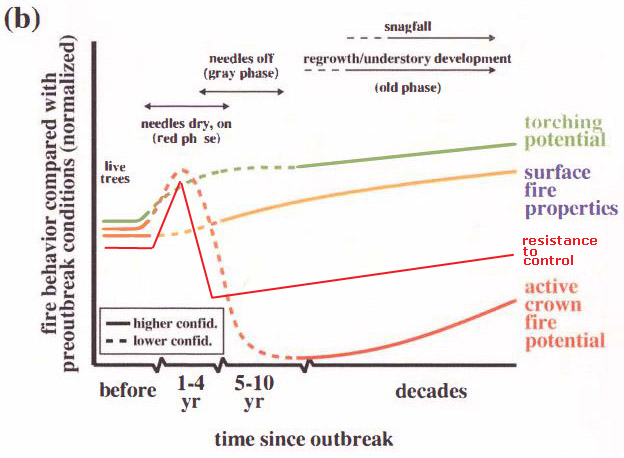More researchers have recently come to the same conclusions others have about the effect that bark beetles have on wildland fire behavior. Some people see beetle-killed trees and intuitively think that fire behavior will be greatly increased in those areas. There is not complete agreement on this, but at least two recent studies have concluded that beetle killed trees do not substantially increase the risk of active crown fire, at least in lodgepole pine (Pinus contorta) and spruce (Picea engelmannii)-fir (Abies spp.). We said the same thing as early as two years ago.
The latest research paper is titled “Do Bark Beetle Outbreaks Increase Wildfire Risks in the Central U.S. Rocky Mountains? Implications from Recent Research”. The authors were Scott H. Black, Dominik Kulakowski, Barry R. Noon, and Dominick A. DellaSala, from the Xerces Society, Clark University, Colorado State University, and Geos Institute, respectively.
Their taxpayer-funded research is available to taxpayers if we pay an additional fee to the Natural Areas Journal. (UPDATE January 24, 2013. We contacted one of the authors, Dr. Barry R. Noon, and he graciously sent us a copy of the paper.)
But their abstract can be read on the internet for free. Here is an excerpt:
…We review the literature on the efficacy of silvicutural practices to control outbreaks and on fire risk following bark beetle outbreaks in several forest types. While research is ongoing and important questions remain unresolved, to date most available evidence indicates that bark beetle outbreaks do not substantially increase the risk of active crown fire in lodgepole pine and spruce-fir forests under most conditions. Instead, active crown fires in these forest types are primarily contingent on dry conditions rather than variations in stand structure, such as those brought about by outbreaks.
Their conclusions are similar to those in another paper titled Effects of bark beetle-caused tree mortality on wildfire, and was written by Jeffrey A. Hicke, Morris C. Johnson, Jane L. Hayes, and Haiganoush K. Preisler. We wrote about it in June of 2012. They said that the potential for active crown fire would increase somewhat between one and four years after mortality, then it would decrease substantially.
Here, in part, is what we wrote last June about that study:
****
…The author’s confidence in the conclusions reached about torching potential and active crown fire potential for the first ten years was low, but it is probable that active crown potential would increase for the first four years after mortality and then decrease dramatically. Torching potential would probably increase.
Surface fire properties, defined as reaction intensity, rate of spread, and flame length, would likely increase, but the confidence in the prediction for the first four years was low.
The authors pointed out that changes in fire behavior following a pine beetle outbreak…
…may only occur under some environmental conditions. For example, effects may be manifested during intermediate wind speeds (Simard et al., 2011) or in moister conditions, such as earlier in the fire season (Steele and Copple, 2009). Past controversy on this topic can be partly reconciled by this consideration of more specificity about study question, time since outbreak, and fuels or fire characteristic when describing results.
Our view of the research
It would be helpful if all of these parameters and studies could distill the conclusions into one index helpful to land managers and firefighters, which I will call Resistance To Control (RTC). Simultaneous increases in surface fire, torching, and crowning would result in more RTC. But it becomes more complicated to characterize when, for instance, crown fire potential decreases to near zero, while surface fire intensity and torching increase. Long distance spotting is a firefighter’s biggest headache and makes fires almost impossible to control, at least at the head. Crown fires are the major culprit for long distance spotting, but surface fires and individual or multiple tree torching can also create spot fires. And all of this varies, of course, with the weather. Strong winds can make ANY fire very resistant to control as long as the fuels are continuous.
If a person leaps to the possibly incorrect conclusion that all of the fire behavior parameters shown in the chart above are accurate, including the sections with low confidence, then RTC would increase somewhat one to four years after a beetle outbreak, and then would probably decrease since the crown fire potential would dramatically decline. Surface fires, including those with some torching, can be more easily controlled using tactics, sometimes with aerial support, such as direct hand line construction, hose lays, indirect line construction with burnouts, and backfiring from out ahead of the fire. When crowning is the primary method of fire spread, you usually have to wait for either the weather or the fuels to change. Air tankers and helicopters dropping fire retardant or water can be more effective when the fire is confined to the surface, as long as firefighters are on the ground to take advantage of the temporary slowing of the rate of spread, and if the wind is not too strong.
With apologies to the authors of this very good research paper, I took the liberty of adding a Resistance To Control variable to their chart:
And of course the authors of the paper included the familiar phrase, “more research is needed”, which is a mandatory section in every research paper.
The authors, who are employed by taxpayers, arranged to have the government pay a fee to have their paper published by the for-profit Elsevier corporation which is headquartered in the Netherlands. But thankfully, this time the USFS also published it on their U.S. Government web site where taxpayers can access it at no additional charge.
If you believe taxpayer-funded research should always be available to taxpayers freely over the internet, go to the White House web site and sign the petition. (Update Jan. 23, 2013: you can still read the petition at the site, but it is closed to new signers. About 60,000 people signed it.)
